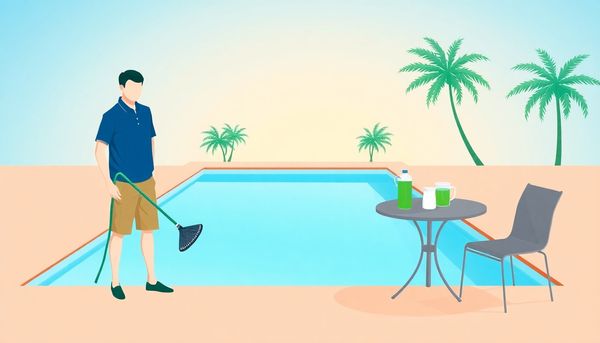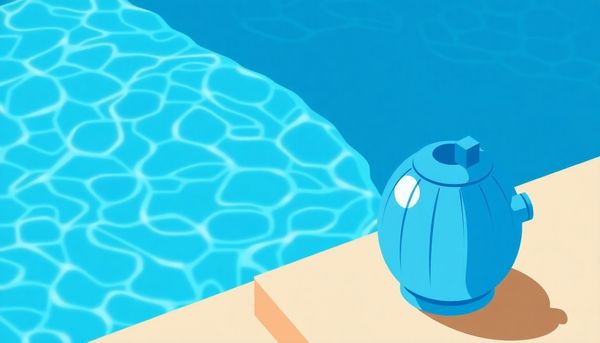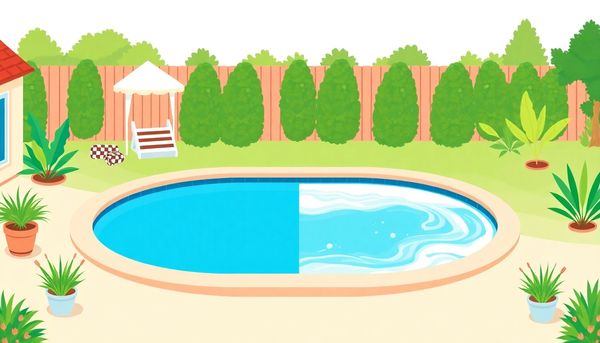Expert Guide: Essential Tips for Balancing Pool Calcium Hardness
February 15th, 2024
February 15th, 2024
Floating atop the shimmering surface of a backyard pool, the water seems deceptively simple—a blue expanse perfect for a summer swim. Yet, as any pool owner knows, maintaining that inviting environment requires a careful balance of chemical components, each playing a crucial role in water quality. Among these, calcium hardness often lurks as an unsung hero or villain. When it's too low, surfaces can erode, damaging the pool's structure. Too high, and the water may turn cloudy, leaving unsightly scale deposits.
Picture a friend who once faced a dilemma with her pool, an oasis turned battleground due to neglected calcium levels. Over time, the water became cloudy, and crusty deposits lined the tiles. The beauty of her private paradise faded, replaced by frustration and a determination to restore balance. This saga serves as a reminder: understanding and managing calcium hardness is essential for every pool owner.
Achieving the right calcium hardness is not just about avoiding problems; it's about ensuring a long-lasting, comfortable swimming experience. The magic lies in the details—regular testing, knowing when to adjust, and understanding the interplay with other chemicals. Embrace the challenge with a proactive approach, and your pool can remain a sanctuary, a place of relaxation and joy, rather than a source of unexpected woes.

Balancing the calcium hardness in your pool is akin to maintaining harmony in a finely tuned orchestra. Each element must be in its place to create something beautiful. Too much calcium, and you’re dealing with a cloudy mess that not even the sunniest day can brighten. Too little, and the very structure of your pool is at risk, as the water corrodes surfaces and equipment. This delicate dance requires understanding and attention, but mastering it will ensure your pool remains a sparkling oasis.
Think of calcium as the Goldilocks of your pool chemistry. It needs to be just right. Water naturally carries minerals, calcium being a prime player among them, but the source of your water contributes significantly to its initial levels. For example, if your home draws from a well, the chances are higher that your starting point is above the ideal range. Regular testing is your best ally here, using a reliable test kit to keep tabs on this mineral's concentration.
When the calcium level strays, adjustments are necessary. If you find your pool has become a giant mineral bath, options like draining some water or using a flocculant might be necessary to bring it back in line. Conversely, for a pool that’s feeling a bit too smooth, a calcium hardness increaser can be added. With consistent monitoring and tweaks, achieving clarity and protecting your investment becomes straightforward, ensuring that every swim is as refreshing as intended.
When it comes to maintaining your pool's water chemistry, monitoring calcium levels should be as routine as checking the oil in your car. Much like the engine that keeps your vehicle purring, your pool's delicate balance hinges on keeping calcium hardness in check. Just as you wouldn't drive your car without oil, you shouldn’t let calcium levels go unchecked in your pool. Every responsible pool owner knows the drill—keeping the chemistry right makes for a long-lasting, problem-free oasis.
Testing your pool's calcium hardness regularly is a straightforward task that saves time and money in the long run. Consider investing in a reliable test kit; it’s an essential tool in your pool maintenance arsenal. By testing weekly, you can catch any deviations early. A friend once learned this the hard way—she ignored her pool's cloudiness for weeks, thinking it was just a bit of dirt. Turned out, her calcium levels had skyrocketed, leaving a stubborn chalky film over everything. It was a costly lesson but one that highlights the importance of diligence.
Moreover, maintaining those ideal calcium levels prevents unpleasant surprises. High calcium can cause scaling, while low levels might lead to corrosion. Neither scenario is kind to your pool's surfaces or your wallet. By keeping a close eye on these levels, you’ll not only ensure the longevity of your equipment but also enjoy crystal-clear water that’s always ready for a splash. Regular monitoring, then, is your ticket to a carefree swimming season.
Maintaining the correct calcium hardness level is crucial not just for water clarity but, importantly, for the longevity of your pool's equipment. That filter you splurged on or the pump that quietly hums in the background—they're more sensitive than you might think. A pool with high calcium hardness can lead to scale buildup, which clogs filters and restricts water flow, reducing the efficiency of your equipment. Imagine having to dismantle your pool pump to scrape off stubborn calcium deposits. Not exactly a fun weekend project.
On the other hand, water that's too soft poses its own set of threats. It might sound counterintuitive, but soft water can aggressively leach minerals from plaster, concrete, and even metal components. This can result in pitting or corrosion, which isn't just unsightly—it's expensive to repair. Remember when your neighbor had to replace their entire heat exchanger? That wasn’t just a rumor; it was the unfortunate reality of neglected calcium levels.
By regularly checking and adjusting the calcium hardness of your pool, you're essentially buying insurance for your equipment and extending its life. It's a straightforward process but pays off significantly in the long run. Regular testing and adjustments keep the water balanced, protect your investment, and ensure that your pool remains a sanctuary of relaxation rather than a source of frustration.
Water hardness in your pool is a bit like cooking with salt—too much or too little can spoil the dish. The minerals in your water, primarily calcium, can affect your pool's clarity and health. If you live in an area with hard water, you might notice mineral buildup not just in your showerhead but also sneaking into your backyard oasis. This calcium presence isn't necessarily bad; it’s all about balance.
When calcium levels soar, you might see your pool water turn cloudy. This isn't just an aesthetic issue; it’s a signal that your pool's delicate chemical harmony is disrupted. And if ignored, the calcium can settle, creating unsightly crusts on surfaces and potentially damaging pool equipment. Lowering calcium levels can be tricky, often requiring partial draining and refilling with softer water. Alternatively, using a specialized product to bind excess calcium can help.
Conversely, water that’s too soft can lead to corrosion, a silent menace that chips away at your pool’s structure. Thankfully, boosting calcium levels is a breeze compared to reducing them. Simply measure your pool’s volume and add a calcium hardness increaser according to package instructions. It's like adding a pinch of salt when the soup's just a tad too bland.
Regular testing and adjustments not only protect your investment but also keep your pool inviting. Balancing calcium is a bit like tending a garden—constant care leads to flourishing results. Keep those levels in check, and your pool will remain a refreshing retreat.

One summer, while basking in the sun beside my pool, I noticed a peculiar white crust forming on the edges of my pool tiles. Intrigued, I discovered that excessive calcium buildup was silently wreaking havoc on my pool equipment. This experience taught me that preventing pool equipment damage starts with managing calcium hardness.
Calcium, when unbalanced, is a silent saboteur. When levels soar beyond the recommended 200-275 ppm range for concrete pools, or 175-225 ppm for vinyl or fiberglass liners, calcium deposits crystalize on vital pool components. This can clog filters, throttle heaters, and even jam up pumps, leading to costly repairs or replacements. On the flip side, water too low in calcium is equally menacing. It becomes aggressive, leaching minerals from plaster and corroding metal fittings, turning pristine equipment into rusty relics.
Regular testing becomes your knight in shining armor. Armed with a reliable pool test kit, you can swiftly identify and adjust calcium levels. If you're short on time, consider automated pool systems that maintain chemical levels, reducing the burden on your shoulders.
Incorporating these practices into your routine isn’t just about prolonging equipment life; it also keeps your swimming sanctuary inviting and clear. So, the next time you lounge by your pool, you can do so with peace of mind, knowing every component is in harmony.
Balancing calcium hardness in your pool is akin to walking a tightrope; a delicate act, but with practice, it becomes second nature. My neighbor Mary learned this the hard way. Her pool, once the pride of summer barbecues, turned milky white overnight. A quick test revealed sky-high calcium levels—a consequence of neglecting regular checks.
To prevent calcium chaos, familiarity with your pool’s unique needs is crucial. Water originating from wells or areas with naturally hard water tends to skew the balance, introducing minerals like calcium into the mix. Whether your pool boasts a vinyl or fiberglass lining or a robust concrete shell, understanding the ideal calcium hardness levels is the first step. These levels range from 175 to 275 ppm, depending on your pool's material.
Too high, and you risk cloudy water and stubborn scale deposits that cling to tiles like unwelcome barnacles. Too low, and the water turns aggressive, nibbling away at metal fixtures and dissolving plaster. When excess calcium is at fault, employing a flocculant can help settle calcium particles, making it easier to vacuum them away.
Meanwhile, a deficiency is swiftly corrected with a calcium hardness increaser. This handy solution restores balance, preventing corrosive water from wreaking havoc on your pool’s infrastructure. Regular testing keeps you informed, allowing you to adjust before problems escalate.
By maintaining vigilance and adjusting with precision, you keep your aquatic oasis clear and inviting, ensuring countless worry-free splashes for seasons to come.
Too-soft water might sound harmless, almost pleasant, like a gentle breeze or soft cotton. But in the world of pools, it's a hidden menace. When pool water lacks sufficient calcium hardness, it becomes aggressive, seeking out minerals wherever they can be found. This can mean trouble for pools with concrete or plaster surfaces. Imagine the slow erosion of your pool walls, as the too-soft water greedily dissolves calcium from the very structures meant to contain it. It's not just the walls either; any metal parts in contact with the water, like ladders or light fixtures, become vulnerable to corrosion.
Fortunately, addressing this issue is straightforward. Increasing the calcium hardness is simpler than it sounds. Grab a calcium hardness increaser—typically a granulated product—and add it according to the instructions on the package. Knowing your pool’s volume is key here; this ensures you add the correct amount. A good pool calculator can help with this, making the task much easier.
Regular testing of your pool's water chemistry is essential. This vigilance helps maintain not just calcium levels but the overall health of your pool. By staying on top of these details, you avoid costly repairs and keep your pool ready for lazy summer afternoons. After all, a well-maintained pool promises endless enjoyment, free from the silent threat of too-soft water.
Balancing the calcium hardness in your pool can feel like walking a tightrope, but maintaining consistent water chemistry is the safety net that keeps everything in harmony. Regular testing is your first line of defense. A simple water testing kit helps you identify imbalances before they become serious issues. This routine checks for calcium hardness, but also ensures that alkalinity, pH, and chlorine levels remain steady. A friend once told me her pool became a source of stress rather than relaxation until she made testing a weekly habit. The clarity of her water—and her mind—made a noticeable transformation.
In addition to testing, water source matters significantly. If you’re filling your pool with hard water, it’s wise to pre-treat it using a water softener or filter. This simple step can prevent complications down the line, reducing the chances of scaling on pool surfaces. Seasonal changes bring their own challenges too. Rainfall can dilute pool water, while evaporation concentrates minerals, both affecting calcium levels.
Adjusting your pool care routine with the seasons helps keep things in balance. Adding a bit more attention to these details can save you heaps of trouble and expense in the long run. With consistent care and a watchful eye, your pool can remain a pristine oasis, welcoming you to relax and enjoy, without the worry of unseen chemical chaos lurking beneath the surface.

Testing and adjusting calcium levels can seem like deciphering a puzzle with ever-shifting pieces. You test your pool water, hoping the results align with ideal values, and when they don't, a plan of action is required. Begin with a reliable test kit designed specifically for calcium hardness. Dip those strips or fill that vial, and then check the reading. Numbers tell stories—stories of too much, too little, or just right. If they whisper that calcium levels are beyond the appropriate range, it's time to act.
If your pool's calcium hardness is high, draining a portion of the water and refilling with fresh water can help dilute the concentration. This method is straightforward but ensures you’re not compromising the pool’s structural integrity. On the other hand, low calcium hardness demands an addition—a calcium hardness increaser. This product, usually in granular form, can be evenly broadcast across the pool surface. Follow package instructions diligently to avoid overshooting the mark.
Remember, adjustments aren’t a one-time fix; monitoring is essential. Schedule regular testing, especially after heavy rainfall or pool refills, as these can skew the balance. It’s akin to adjusting a recipe—too much or too little can change the dish entirely. Over time, your intuition will grow, making this task feel like second nature. Keep your pool’s calcium levels in check, and you'll ensure a season of carefree swims and crystal-clear water.
Maintaining the perfect shimmer of your pool is a bit like balancing on a tightrope, and calcium hardness is one of those unexpected gusts of wind that can make things wobbly. Monitoring calcium hardness isn't just a task—it’s an art. Regular checks with a reliable test kit can save you from a host of troubles. Think of it as the regular check-up your pool needs. Just like you wouldn’t ignore a strange noise under the hood of your car, don’t turn a blind eye to the numbers on your test strip.
In my own experience, during a particularly scorching summer, I noticed my pool starting to cloud despite having just shocked it. It turned out the culprit was elevated calcium levels from evaporation and frequent topping off with hard water. A quick test confirmed it, and I was able to dial back on the damage before it became a real headache. This little ritual of testing helps you catch issues early—whether it’s scaling or corrosion—before they transform your backyard oasis into a repair project.
Remember, the goal is balance. Aim to keep calcium levels in harmony with the type of pool you have. For a concrete or plaster pool, stay within that 200-275 ppm sweet spot. Vinyl or fiberglass pools prefer slightly less, around 175-225 ppm. By keeping a watchful eye, you ensure your pool remains a place of joy rather than a source of stress.
A shimmering pool under the summer sun can be the centerpiece of backyard gatherings, offering a refreshing escape from the heat. But underneath the surface, balancing pool water chemistry is a task that demands attention, especially when it comes to calcium hardness. This isn’t just about keeping your water clear; it's about safeguarding your pool's longevity and performance.
Consider this: your water source might already be packed with minerals. If you're sourcing from local municipal water or a well, the calcium levels can fluctuate more than you imagine. While calcium is crucial for strong bones, in a swimming pool, it’s a different story. Excess calcium can lead to cloudy water and unsightly scaling on pool surfaces—your pool’s version of wrinkles. On the flip side, insufficient calcium levels can cause corrosion, eating away at metal components and even eroding concrete.
Each pool type has its sweet spot for calcium hardness. Concrete pools thrive with levels between 200-275 ppm, while vinyl-lined or fiberglass pools are happier with 175-225 ppm. Testing kits are your trusty allies in this balancing act. They quickly provide insight into whether you need to tweak the chemistry, ensuring your pool stays in top condition.
Maintaining this balance is not just about aesthetics; it's about preserving your investment. A well-balanced pool is less prone to damage, saving you from costly repairs and ensuring that the sparkling oasis remains a joy to dive into all season long.
Calcium-related damage in your pool isn’t just an inconvenience; it’s a costly affair waiting to happen if not properly managed. Picture this: a cloudy pool that seems to defy all your shocking efforts, or worse, a stubborn white crust clinging to your prized pool tiles. This isn't just an aesthetic issue—it's a sign that your calcium hardness levels might be spiraling out of control. When calcium levels become excessive, your pool water can transform into a minerally-charged solution, ready to plaster your pool surfaces with unsightly deposits.
Reducing these calcium levels can involve partial draining and refilling with fresh water, especially if your local supply is softer. Alternatively, consider using a commercial scale reducer to dissolve existing deposits and inhibit further buildup. Keeping a watchful eye on your calcium levels isn’t just about preventing visible damage; it’s about preserving the longevity of your pool equipment, too. High calcium can lead to scaling in filters and heaters, impairing their function and potentially burning a hole in your pocket with repair costs.
On the flip side, water that is too soft poses its own threats. It can corrode metal ladders, fittings, and even lead to the degradation of your pool surface. Therefore, regular testing and adjustments are crucial. They form the backbone of effective pool maintenance, ensuring your sanctuary remains a haven of fun, not frustration.

When the sparkling surface of your pool starts to lose its luster, and cloudy water or stubborn white deposits begin to appear, it could be more than just a bad day for your pool—it might be a sign of high calcium levels. Unexpectedly, these deposits can lead to clogged filters and rough, unsightly pool surfaces that make swimming less enjoyable. As a pool owner who once found herself perplexed by a film of white scaling around the waterline, I learned a few tricks to tackle this sneaky issue.
First, consider draining a portion of your pool water and refilling it with fresh, less mineral-rich water. This dilution method can effectively lower calcium concentration, especially if your tap water is softer. Remember, though, always check local regulations before draining your pool, as there might be restrictions due to environmental concerns.
A more advanced approach involves using a flocculant. This chemical binds the excess calcium, forming larger particles that can be vacuumed away after they settle at the pool's bottom. However, patience is key here, as this process can take a day or two to fully clear the water.
Lastly, employing a sequestering agent can help. This product keeps calcium dissolved, preventing scale formation. Though it won't remove calcium, it buys you time to address the root issue.
By experimenting with these methods, you'll find the best fit for your pool’s personality, keeping your oasis invitingly clear.
Balancing the calcium levels in your pool is akin to maintaining a cherished recipe—too much or too little of one ingredient can tip the entire balance. Despite its essential role in the body, calcium in pool water must be kept in check to safeguard your swimming sanctuary. The ideal calcium hardness level varies based on your pool's construction. For vinyl or fiberglass pools, aim for levels between 175 ppm and 225 ppm. Concrete or plaster pools require a slightly higher range, from 200 ppm to 275 ppm. Finding this sweet spot ensures that your pool remains inviting and your equipment stays in tip-top condition.
Picture this: a sunlit afternoon spent lounging by the pool, only to find that the water has turned cloudy. This isn't just an aesthetic concern—it's often the first sign of imbalanced calcium levels. Excess calcium can lead to unsightly scaling on surfaces and may cause filters to clog. On the flip side, insufficient calcium makes the water aggressive, potentially damaging your pool's surfaces and components.
The solution is straightforward. If levels are too high, partial draining and refilling with fresh water can help. Conversely, for soft water, a calcium hardness increaser will do the trick. Regularly testing your pool water ensures that the balance is maintained. My own pool-maintenance routine includes a weekly check to ward off any surprises and keep my backyard oasis crystal clear. Investing a little time in testing now can save you a bundle on repairs later.
The subtle menace of calcium buildup can transform your sparkling oasis into a maintenance nightmare. This sneaky intruder leaves behind unsightly white scales on pool surfaces and equipment, diminishing their lifespan and aesthetics. To sidestep this common pitfall, regular monitoring is your best ally. Begin by testing your water frequently, especially if your local water supply is notorious for its mineral content. A good friend of mine once faced this very issue, discovering too late that her pool’s shining tiles were becoming dull and rough to the touch.
To combat high calcium levels, dilution is often a straightforward remedy. Consider draining a portion of your pool and refilling it with fresh water. This tactic works wonders, particularly if your source water is lower in minerals. Additionally, a sequestrant can be your next line of defense; it binds with calcium particles, preventing them from forming scales.
But let’s not overlook the power of preventing buildup in the first place. Keep an eye on pH and alkalinity levels, as imbalances in these can encourage scale formation. Aim for a pH between 7.4 and 7.6 and maintain alkalinity in the 80 to 120 ppm range. By taking proactive steps, you'll keep your pool inviting and equipment in top shape, ensuring more time splashing and less time scrubbing.
In the world of pool maintenance, safeguarding your pool equipment from calcium-related damage is crucial. Remember the time when your pool pump started making unusual noises, or the heater efficiency dropped significantly? These could be signs of calcium scaling—a silent threat that creeps in when calcium hardness levels are left unchecked. This sneaky villain can deposit stubborn, unsightly scales on surfaces and within equipment, restricting water flow and reducing efficiency. Imagine the frustration of discovering a costly repair bill just because a simple chemical oversight went unnoticed.
Consider the pool filter, for instance. When calcium levels soar, these minerals can clog the filter media, forcing your filtration system to work overtime. Not only does this lead to higher energy consumption, but it also shortens the lifespan of your equipment. The same applies to pool heaters, where calcium buildup can insulate heating elements, leading to inefficiencies or even total failure.
By regularly testing and adjusting calcium hardness, you shield your equipment from undue stress and wear. Simple actions, like routinely testing water and adjusting mineral content with the appropriate chemicals, can save you from future headaches. Besides, maintaining optimal calcium levels means your pool water remains crystal clear, providing a welcoming oasis that’s always ready for a refreshing swim. So, prioritize calcium balance, and let your pool equipment enjoy a long, trouble-free service life.

Corrosion might not be the first thing that comes to mind when you think of pool maintenance, yet it’s a sneaky issue that can wreak havoc if calcium hardness levels aren’t properly managed. Consider this: a pool with water that’s too soft can slowly eat away at your investment, dissolving concrete, plaster, and any metal parts it touches. This destructive process doesn’t just damage your pool's structure; it can lead to costly repairs and replacements that could have been easily avoided.
Maintaining balanced calcium hardness is akin to striking a delicate balance between protecting your pool’s surfaces and ensuring the safety of its users. When water lacks sufficient calcium, it becomes aggressive, searching for minerals wherever it can find them—often at the expense of your pool. The solution, however, is straightforward. Introducing a calcium hardness increaser can quickly bring your levels back to where they should be, preventing potential corrosion. Just be sure to measure accurately, as knowing your pool’s volume is crucial for adding the right amount.
Regular testing and adjustments, using a reliable test kit, are your best defenses against the corrosive effects of low calcium hardness. It’s a simple yet essential routine that secures the longevity of your pool and ensures a seamless swimming experience for everyone. Keeping corrosion at bay is not just about maintaining a pool; it’s about preserving the joys it brings.
When it comes to managing calcium hardness in your pool, it's all about finding that sweet spot for your water's health and longevity. Remember the last time you spent hours scrubbing stubborn calcium deposits off tiles? That’s exactly what you’re trying to prevent by keeping those levels balanced. The trick is to stay ahead of the game with regular testing using a reliable pool test kit that can measure calcium hardness alongside other vital metrics like pH and chlorine.
Why is calcium hardness such a finicky player? Well, if levels are too high, your pool water becomes 'hard', leading to cloudy water and unsightly scale buildup. Picture a serene swimming experience marred by gritty surfaces and dulled tiling—unpleasant, right? To remedy this, you can partially drain your pool and refill it with fresh water. This dilutes the excess calcium, bringing balance back to your pool.
On the flip side, when calcium levels drop too low, the water turns aggressive, corroding metal fixtures and etching pool surfaces. Imagine the frustration of dealing with pitted concrete or a compromised pool filter. To elevate the calcium hardness, a simple addition of a calcium hardness increaser will do the trick. Always follow the product instructions, and ensure accurate measurements by knowing your pool's volume.
Regularity is your best friend. Testing weekly and adjusting as needed ensures that your pool remains both a safe haven and a crystal-clear centerpiece for relaxation. With a little diligence, you can enjoy worry-free swimming sessions all summer long.
Balancing the water in your pool is like keeping a delicate dance in perfect rhythm. When calcium hardness is just right, your pool becomes a sanctuary of relaxation and fun. Yet, when mismanaged, the consequences can hit your wallet hard. A friend once shared the story of his own pool turning into a science experiment gone wrong—white crusty deposits clinging to the tiles like barnacles on a ship. Such calcium buildup not only mars the aesthetic but can also damage the pool’s infrastructure.
Start by recognizing the signs of imbalance. Cloudy water or scaling on surfaces signals high calcium levels. Imagine trying to clear it with pool shock only to see the haze stubbornly linger—frustration at its peak. The solution? A dose of patience and a calcium hardness reducer will work wonders. On the flip side, if your water feels more corrosive than refreshing, it might be too soft, lurking like an invisible threat to your pool’s surfaces and metal fixtures. Adding a calcium hardness increaser is your ticket to restoring balance.
Regular testing becomes your best ally. Much like checking the oil in a car, it's essential for longevity and performance. Simple test kits available online or at local pool stores can guide you, making the process straightforward. By maintaining a sharp eye on these levels, you’re not just preserving your pool—you’re ensuring endless hours of splash-filled joy without the looming threat of costly repairs.

This article provided insights into maintaining your pool. Start your pool care journey today!
Want to become a pool maintenance expert? Our free Pool School course covers everything you need to know about pool care. From basic maintenance to advanced troubleshooting, you'll learn how to:
Join over 10,000 pool owners who have already transformed their pool care routine. Get started with our free Pool School course today!